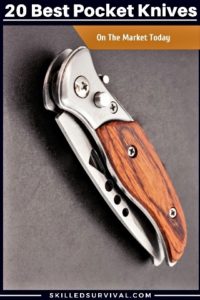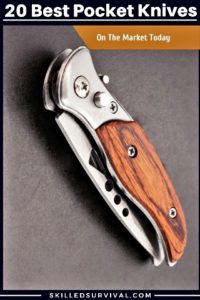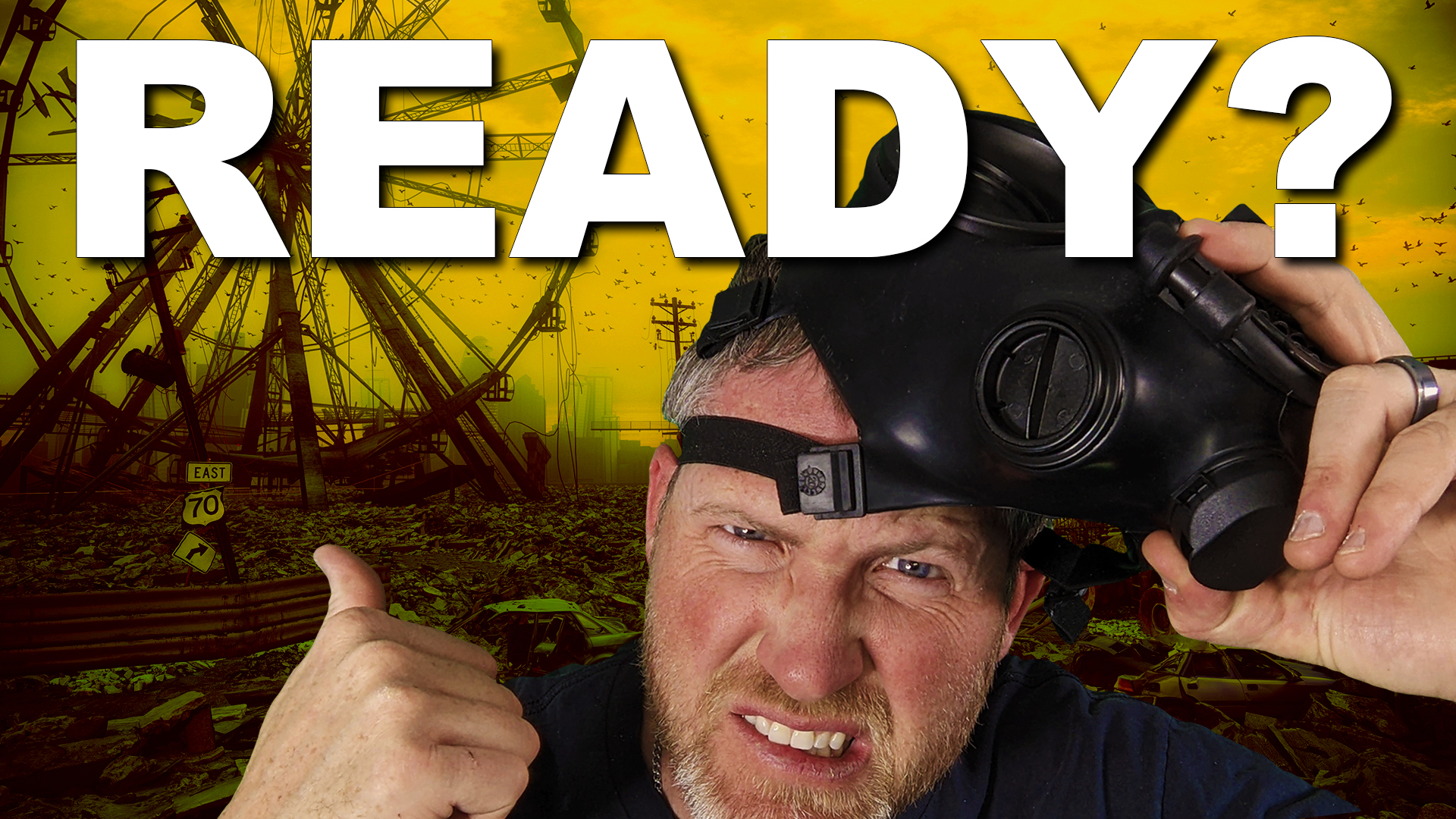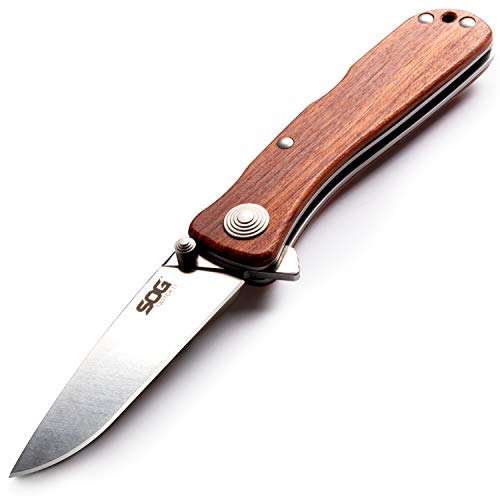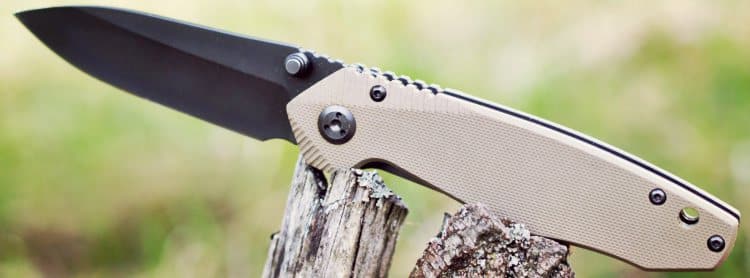Looking For The Best Pocket Knife For YOU? You’re In The Right Place
Why? Because there are thousands of different pocket knives on the market today.
Which is a good thing, right?
Yes and No!
More choice is usually welcomed, but TOO MUCH choice quickly becomes overwhelming!
That’s where Skilled Survival comes in – we love to analyze gear!
Our team spent countless hours researching.
And years worth of hands-on experience with all sorts of survival gear, such as:
- Tactical Knives
- Best Survival Knives
- Survival Tents
- Tactical Backpacks
- Best Survival Lighters
- Tent Heaters
- Bulletproof Backpacks
- Folding Saws
- Best Karambit Knives
- Tactical Belts
- Etc.
The bottom line is:
We know survival gear, and we aim to provide trustworthy advice.
That’s why today I’m going use my extensive Survival Gear Review experience, Engineering Degree, & Mountain Rescue Service to share the following:
TABLE OF CONTENTS
Best Pocket Knives For Sale
What’s A Pocket Knife Anyway?
Why Carry A Pocket Knife
Choose The Best One For You
Are You Ready For The Tough Times Ahead? Take My 60 Sec Quiz To See If You’re Part Of ‘The Fragile Masses’ Or Not… Start Quiz Now!
Best Pocket Knives On The Market Today
We looked over various designs, price points, and manufacturers.
Our goal is to provide you with a good sampling of the best pocket knives on the market today:
Ontario Rat II Folder OD Green
- Weight: 2.75 oz
- Blade Length: 3″
- Blade Steel: D2
- Locking Mechanism: Liner
We’ve looked at other Ontario blades in the past and been impressed.
They’re a budget-friendly option that retains quality.
The RAT II is another excellent example of an inexpensive folding pocket knife that gets the small details right.
The new version features D2 steel.
This steel holds an edge better than the previous AUS-8 stainless steel version.
Given that D2 isn’t stainless, the tradeoff is some additional maintenance.
Clean your blade after use and periodically wipe it down with a light oil will ensure it lasts a long time.
The G10 grips provide excellent traction even in poor conditions.
And the 4-position pocket clip allows you to carry EXACTLY how you’d like.
No compromises!
Dual thumb studs also serve to make this more ambidextrous design.
All in all, a high-quality blade for a steal!
PROS
- Inexpensive
- 4-position pocket clip
- D2 steel holds an edge well
CONS
- It needs some minor regular maintenance
- No flipper for opening
↓ The Ontario RAT 2 In D2 Steel Review ↓
Cold Steel 58B American Lawman
- Weight: 4.0 oz
- Blade Length: 3.5″
- Blade Steel: S35VN
- Locking Mechanism: Tri-Ad (Lockback)
When I’ve looked into Cold Steel knives, they’ve all been massive, bulky fixed blades.
This means they’re often more suited for chopping trees and batoning firewood.
Looking online, I see that I’m not alone in that impression.
The American Lawman is still an excellent, practical design. But at a much more reasonable scale.
They call it “Civilian Friendly” in their advertising.
This phrase is code for “It Won’t Scare Bystanders QUITE As Much.”
Kidding aside, this is a burly knife and well-suited for some major tasks.
The 3.5-inch blade features a clean drop-point with a single continuous curve from choil to tip.
While it’s too deep to carve, it works well for slicing and chopping.
The aggressive Lockback design helps prevent accidental blade closure.
The large choil makes for an excellent grip placement for more delicate work.
But it also provides a bit of a finger guard in the regular grip position.
The lack of a flipper is notable, but the massive thumb stud makes for an easy opening, even with tactical gloves on.
PROS
- BURLY
- Solid Lockback design
CONS
- Heavy for the size
- The blade is too deep for some carving and small space work
↓ Cold Steel American Lawman – Overview And Review ↓
Kershaw Leek Pocket Knife
- Weight: 4.3 oz.
- Blade Length: 3.3 in.
- Closed Length: 4.4 in.
- Blade Steel: 420HC
- Locking Mechanism: Liner
Many people prefer a fast-deploying blade, and the Kershaw Link is one of the best.
The well-designed “kick” moves the blade far enough for the assisted open mechanism to take over and move the blade to the locked position.
The liner lock is reliable, and you can manipulate it with either hand.
This knife also supports lefties.
Because the pocket clip can be re-positioned for either right or left-handed carry.
However, the marketing notes the ability to change the tip position on the pocket clip (tip-up or tip-down).
But there are no additional holes for the blade to be carried tip down.
The blade is well built and does well with slicing, but it’s a little large for detail work like carving.
PROS
- Very fast deploy
- Solid liner lock
- Ambidextrous carry
CONS
- You can NOT adjust the tip position – despite the marketing
- Not the best for carving and small work
↓ Kershaw Leek 1660 Folding Knife ↓
SOG Flash II Assisted Folding Knife
- Weight: 4.6 oz.
- Blade Length: 3.45 in.
- Closed Length: 4.67 in.
- Blade Steel: Cryo D2
- Locking Mechanism: AT-XR (crossbar)
The SOG Flash II is one of the fastest assisted-open folding knives on the market today.
It’s easy to open with either right or left-hand grips.
The deep carry pocket clip is also reversible, making it truly ambidextrous.
You can choose from several different versions of the Flash II on the market.
There’s the original AUS-8 stainless blade and the upgraded D2 steel.
Look for the version with the D2 steel.
It has been cryogenically heat-treated for extra strength.
Be sure to read the details, as both blades sport a titanium nitride finish and are of similar shape.
I prefer the straight-edge version, but the partially serrated version is also a fine knife.
The 3.25-inch blade is big enough that it doesn’t feel like a compromise when half of it is serrated.
A lifetime warranty also means that SOG stands behind its products.
PROS
- Very fast assisted open
- Blade large enough for partial serration to be useful
CONS
- It feels a bit big and bulky
- No flipper actuation, only thumb stud
↓ SOG Flash 2 – Field Test ↓
CRKT CEO EDC Folding Pocket Knife
- Weight: 2.1 oz.
- Blade Length: 3.1 in.
- Closed Length: 4.5 in.
- Blade Steel: 8Cr13MoV
- Locking Mechanism: Liner
The CRKT CEO is another unique blade design.
It looks more like a fancy pen or a letter opener than a modern pocket knife.
It has a narrow profile and a deep carry pocket clip.
This feature makes it nearly indistinguishable from a knife until you open it up.
When you do, the reversible thumb stud and ball-bearing hinge allow for fast action and a smooth feel.
Plus, the liner lock is very secure.
The glass-reinforced nylon handle is super light.
And the fit and finish make it comfortable in your hand.
So if your office dress code swings more towards dark suits than jeans, the CEO might be the best EDC pocket knife for you.
PROS
- Very discrete
- Ambidextrous opening mechanism
- A narrow blade is excellent for detail cuts
CONS
- Pocket clip only on one side, not adjustable
- It may need sharpening right out of the box
↓ CRKT CEO Is…Awesome! ↓
Opinel No.08 Stainless Steel Folding Knife
- Blade Length: 3.4 in.
- Blade Steel: XC90 carbon
- Locking Mechanism: Collar
Nearly unchanged for the past 130 years, the Opinel is a “must-include” on any list of best pocket knives.
The Opinel ranges from the tiny No2 (1.36″ blade) up to the large No12 (4.82″ blade).
But all feature the same hard beechwood handle and thin, razor-sharp edge.
The No6 knife also gains a collar lock.
This collar lock is a steel band around the hinge point, preventing accidental rotation.
It’s a straightforward mechanism that works well if you keep the steel free of debris or corrosion.
Some users mention it’s tight and hard to rotate when first purchased.
But it slowly relaxes and is easier to deploy over time.
The blade is very sharp, even right out of the box, but it’s also relatively thin.
That’s why it’s NOT a knife for chopping or ANY prying, but it excels in slicing.
The round beech handle is both light and comfortable. But it can take a bit of getting used to if you have only had knives with more rectangular handle cross-sections.
It’s also incredibly light in your pocket, which is nice for a knife with no pocket clip.
PROS
- Inexpensive
- Lightweight
- Very sharp blade
CONS
- No pocket clip
- The collar lock is slow to deploy
- The thin blade can snap if used roughly
↓ OPINEL No.8 Carbon Steel Knife ↓
Gerber Gear Flatiron Micarta Folding Pocket Knife Cleaver
- Weight: 5.2 oz.
- Blade Length: 3.6 in.
- Closed Length: 4.8 in.
- Blade Steel: D2
- Locking Mechanism: Frame
The majority of the blades on this list are the venerable drop-point shape.
However, there are a few impressive exceptions.
These folding knives come with a unique profile that helps them stand out.
The Gerber Flatiron is undoubtedly distinct.
It comes with a mini-cleaver design and a nearly flat cutting edge.
This bold design choice makes the Flatiron a more beefy blade throughout.
This blade design isn’t just for looks; it also adds durability.
The flat cutting edge is straightforward to sharpen, especially on a quality pocket knife sharpener or whetstone.
Even a new user can get a razor-sharp edge.
However, it doesn’t leave a small tip for working in tight areas.
So there’s no way you’re poking this under a rope to cut away from the surface.
However, it’s good at shaving down materials (i.e., whittling kindling sticks for a fire).
Another consequence of this blade shape is the extra weight.
This extra weight results from the extra bulk toward the blade’s tip.
That’s why the Flatiron is noticeably heavier than similar-length drop-point blades.
To keep a grip on things, the Micarta handles feel great.
It has enough texture for grip but is not too aggressive to become uncomfortable.
PROS
- Durable
- Unique styling
- Comfortable grip, including extra-large choil
CONS
- Awkward for smaller spaces
- Heavy for size
- High carry pocket clip is concise and wide
↓ Gerber Flatiron With D2 Steel ↓
SOG Twitch ll Drop Point Pocket Knife
- Weight: 2.6 oz.
- Blade Length: 2.65 in.
- Blade Steel: AUS-8 Stainless Steel
- Locking Mechanism: Lockback
SOG is a company based in Seattle, WA.
And the Twitch II is a classic pocket knife that ably handles any EDC task.
Over the years, it has become a customer favorite for a good reason!
It’s perfectly sized for both the hand and the pocket.
So it has enough weight to know it’s still there but not enough to drag you down.
The construction makes it easy to open and reliably engages the lock mechanism.
A dual-sided thumb stud complements the “kick” opening mechanism.
This setup allows for both right and left-handed operations.
Similarly, the pocket clip can be placed on either side, giving multiple carry options.
Now, I generally don’t choose stainless steel blades.
However, this one is sharp from the factory and holds an edge well.
The drop-point blade is well balanced and up to a variety of tasks.
The Lockback design is stable.
However, I would have liked to see a liner lock or other mechanism with a little more durability.
It’s joined by a small safety lock that keeps the blade closed in your pocket.
This feature adds more security against accidental deployment.
PROS
- Solid construction
- Great balance
- Ambidextrous
CONS
- The Lockback mechanism can wear out over time
↓ Reviewed: SOG Twitch II Rosewood ↓
Kershaw Fraxion Folding Pocket Knife
- Weight: 2.0oz
- Blade Length: 2.75 “
- Blade Steel: 8Cr13MoV
The Kershaw Fraxion, designed by Jens Anso, is a striking (and inexpensive) choice for an EDC knife.
The angular handle and blade make it a unique shape among its competitors.
The G10 and carbon fiber composite handle is an excellent buy at this price point.
It’s feather-light as well, only 2 ounces!
The 8Cr13MoV Cro-Moly stainless steel has a subtle concave curve to the belly.
This slight curve makes it easier to slice. And the jimping on the back of the blade offers more thumb control when carving.
As with other knives, the marketing states that this knife boasts a 4-position pocket clip.
But inspection of the handle shows only two mounting points – a tip-up position on either the right or left pockets.
On another note, several forums show the hinge may need a little lubrication to swing freely.
Hoppes gun oil works great for this.
PROS
- Super lightweight
- Striking design
- Inexpensive
CONS
- Only a 2-position pocket clip
- The hinge may need lubrication
↓ Kershaw 1160 Fraxion Knife Review ↓
Boker Magnum Lil Lambfoot EDC Pocket Knife
- Weight: 3.14 oz
- Blade Length: 2.05 “
- Blade Steel: 8Cr13MoV
- Locking Mechanism: Frame Lock
Check out the Boker Magnum Lil if you want a small blade, whether limited by legal restrictions or just discretion.
It’s small at 2.05″, but the lambfoot blade has a large curve to maximize cutting edge length.
The steel works well and holds an edge, making this an excellent knife for utility tasks.
Like any small knife, the handle can feel cramped after prolonged use.
So the Boker is perfect as a backup EDC or for situations where a larger knife would draw undue attention.
The large thumb hole makes for easy opening, and the frame lock securely holds the blade.
PROS
- Long cutting edge for blade length
- Jimping helps with control
CONS
- Cramped hand position
↓ Boker Lil Lambfoot – Unboxing And Overview ↓
Boker Plus Lancer 42 Folding Frame Lock Pocket Knife
- Weight: 4.2 oz
- Blade Length: 2.75 “
- Blade Steel: S35VN
- Locking Mechanism: Frame
While we may not know Boker as a familiar name in the US, they’ve made knives in Germany since the mid-1800s.
The Lancer is a collaboration between Boker and knifemaker Serge Panchenko.
This pairing brings a unique, high-quality folding knife.
The D2 steel sharpens easily and holds an edge well.
However, it does require regular cleaning and oiling.
The carbon fiber handle keeps the weight down.
Plus, the frame lock engages the blade to keep your fingers safe.
My only gripe is the lack of a flipper or thumb stud, relying instead on a thumbnail nick to open the blade.
PROS
- Skinny blade design
- Clean lines and minimal parts
CONS
- Thumbnail nick for opening
↓ The Boker Plus Lancer Pocketknife Review ↓
Tops Mini Scandi Linerlock
- Weight: 3.5 oz
- Blade Length: 3.25 “
- Blade Steel: N690Co
- Locking Mechanism: Liner
TOPS is a relatively unknown brand.
But the Idaho knifemaker has an extensive lineup of fixed blades and a few tremendous folding knives like the Mini Scandi.
It’s a medium-sized pocket knife with a clean, minimal look.
The large flipper and ball-bearing hinge make for an effortless one-handed opening.
Canvas Micarta handle scales are easy to grip.
But (in my opinion) it looks a little like unfinished fiberboard.
Luckily, they wear nicely and develop a patina quickly.
The factory Scandi grind (steep flat primary bevel with no secondary bevel) is excellent for bushcraft.
But some buyers have noted blades with shallow grinds tend to chip more often.
It’s unclear if these are counterfeit or refurbished blades.
But the wide range in the purchase price is suspicious.
TOPS has worked with people to get the proper grind on their blades, which is great to see in a small company.
PROS
- Clean design
- Scandi grind is durable and easy to maintain
- Grippy handle
CONS
- Possible counterfeit issues
- Expensive
↓ TOPS Knives MSF 4.0 Mini Scandi Flipper Overview ↓
Benchmade – Mini Bugout Axis, Drop Point Knife
- Weight: 1.5 oz.
- Blade Length: 2.8 in.
- Blade Steel: CPM-S30V
- Locking Mechanism: Axis (crossbar)
Newer to the scene this year is the Benchmade Bugout Mini.
It’s a scaled-down version of one of their most popular blades, the Bugout.
The new version is lighter, smaller, and more compact than its namesake.
But it still features the same quality and innovation we expect from Benchmade.
The Bugout Mini is feather-light (1.5oz.) thanks to lightweight Grivory handle scales.
The Axis lock is strong and secure – possibly one of the best blade locks on the market today.
The spring offers good pressure to engage the lock while it disengages smoothly.
The 2.8-inch blade is tough, sharp, and capable.
And it still manages to stay under the 3-inch limit many locations impose on pocket knives.
It quickly dispatches a wide range of cutting tasks from cardboard to paracord.
If you drop it, the bright orange handle is easy to find; like it or not, it’ll stand out in your pack.
The discrete white-handled option is just as good if you need to be more discrete in your EDC items.
Even better, it sports a deep-carry pocket clip.
This deep carry allows you to keep it nearly invisible in the corner of your pocket.
PROS
- Very sharp out of the box
- High-quality CPM-S30V steel
CONS
- Expensive
↓ The Benchmade Knives Mini-Bugout Pocketknife Review ↓
Zero Tolerance Sinkevich Pocketknife
- Weight: 3.7 oz
- Blade Length: 3.7″
- Blade Steel: 20CV
- Locking Mechanism: Frame
Zero Tolerance is a high-end niche in the pocket knife market.
But Zero Tolerance’s quality and materials are second to none.
This folding knife sports a slender curved shape.
This slim shape makes it one of Dimitry Sinkevich’s design trademarks.
The long smooth upward curve of the blade makes it an excellent slicing design.
A ball-bearing hinge allows the stainless steel blade to swing open with the flick of a finger.
The 20CV steel comes razor-sharp and holds an edge far better than lesser alloys.
Finally, custom red and grey carbon fiber makes the handle lightweight and strong.
And it’s visually distinct from anything else you’re likely to find.
PROS
- Extremely high-quality materials and build
- Great slicing blade
CONS
- EXPENSIVE
↓ Zero Tolerance Knife Review ↓
Spyderco Para 3 Lightweight Signature Folding Utility Pocket Knife
- Weight: 2.4 oz
- Blade Length: 3″
- Blade Steel: CTS-BD1N
- Locking Mechanism: Compression
The Spyderco Para 3 Lightweight replaces the standard thumb stud with a thumb HOLE on the back of the blade!
This design makes the blade broader and more massive.
This size difference means it’s much easier to open when you don’t have a thumb stud (cold, wet hands, for example).
That’s why it’s so impressive that despite the extra steel used in making the thumb hole, the Para 3 still comes in at just 2.4 oz!
This goes to show how much Spyderco uses lightweight materials throughout the build.
The superior quality steel offers excellent edge retention and sharpens well.
Some users noted the overall balance feels off because of the extra mass in the blade and less in the handle.
This is not a critical flaw, but something to consider if balance counts more than weight savings.
I like the lightweight wire pocket clip.
But it doesn’t feel as securely mounted in the handle as I would like.
PROS
- Lightweight
- Easy-open ambidextrously with cold hands
CONS
- Balance and weight distribution are off
- Pocket clip mounts feel insecure
↓ It’s Good But How Good? Spyderco Para 2 Lightweight ↓
CIVIVI Chronic Folding Pocket Knife
- Weight: 2.5 oz
- Blade Length: 3.25 “
- Blade Steel: 9Cr18MoV
- Locking Mechanism: Liner
The CIVIVI Chronic is another clean, minimalist design that easily blends into an office setting.
At only 2.5 ounces and under 4″ overall, it slips neatly into a pocket with a two-position pocket clip.
The 3.25″ blade arrives razor sharp and is ready for use.
It’s a great EDC blade and excels as a slicer.
A small flipper and ball-bearing hinge make for a fast, ambidextrous opening.
And the liner lock clicks in place effortlessly to keep the blade secure.
A G10 handle provides an excellent grip, even in slippery conditions.
PROS
- Discrete modern styling
- Reversible, deep carry pocket clip
CONS
- The angular handle is not the most comfortable
↓ The Civivi Chronic Pocketknife: The Full Review ↓
Gerber Gear Fastball – Folding Knife with Lock Release for EDC Gear – Flat Sage
- Weight: 2.79 oz
- Blade Length: 3″
- Blade Steel: S30V
- Locking Mechanism: Liner
We’ve already looked at several “entry and mid-range” Gerber blades.
But the Fastball is one of their higher-end products.
It features a Wharncliffe blade crafted from S30V stainless steel.
It also features a pointed tip and a long cutting edge for piercing and slicing cuts.
The high-quality ball bearings and flippers work together to open consistently and smoothly.
But some people found the lock mechanism too tight, pushing the blade off-center while folding.
It has a solid aluminum handle that’ll stand up to a beating.
And it provides a three-position pocket clip that allows for multiple carry options.
It’s US-made, and Gerber stands behind their warranty.
PROS
- Solid metal construction
- Blade suited for piercing and slicing cuts
CONS
- The liner lock may be too tight and cause deflection of the blade in closing
↓ And EDC Home Run? Gerber Fastball ↓
Buck Knives 110 Slim Pro TRX Lock-back Pocket Knife with G10 Handle
- Weight: 3.1 oz
- Blade Length: 3.75 “
- Blade Steel: S30V
- Locking Mechanism: Lockback
Growing up, every adult male I knew carried a pocket knife.
More than a few were old Buck 110s with wooden handles and brass bolsters.
The Buck 110 Slim Pro isn’t the same knife but is a descendant of those old designs.
In the new model, Buck slimmed down the handles and overall mass of the knife.
It also added a removable pocket clip and micarta scales.
The heat-treated S30V stainless steel blade holds an edge and resists corrosion.
It’s a clean update to the old style and still a perfect fit for your pocket and hand.
Don’t worry; if you still want a Buck 110 with brass and wood style, they make that one too.
PROS
- A simple update to the traditional style
- The well-shaped blade has proven suited to EDC tasks
CONS
- Some factory defects were noted but replaced when noted
- The pocket clip is bulky
↓ The Buck 110 Slim Folding Hunter Pro Pocketknife Review ↓
BESTECH KNIVES Thorn Linerlock Brown
- Weight: 3.9 oz
- Blade Length: 3″
- Blade Steel: Sandvik 12C27
- Locking Mechanism: Liner
An inexpensive EDC pocket knife is usually a compromise between cost and quality.
In some cases, you get an upgraded handle and appearance but inferior steel in the blade.
The Bestech Thorn is the opposite.
It’s a knife that compromises little in the blade to keep the costs down.
The 12C27 Sandvik steel is high quality, holds a razor edge, and is still easy to sharpen at home.
The long upswept blade maximizes cutting edge length.
And it gives you the best possible slicing and paring action for the size.
The handle has a plasticky feel.
And the single-pocket clip position isn’t best for everyone, but it’s a solid choice for a budget EDC blade.
PROS
- Inexpensive
- Quality steel
CONS
- The feel of the handle isn’t the best
- Single-position pocket clip
↓ Bestech Torn The Full Review ↓
Gerber Gear Paraframe Mini Pocket Knife
- Weight: 1.4 oz.
- Blade Length: 2.2 in.
- Blade Steel: Stainless steel
- Locking Mechanism: Frame
Over the years, I’ve had several inexpensive Gerber folding knives.
These budget-friendly options include the Paraframe Mini I have carried for years.
They’re simple, straightforward knives with no fancy details or fancy materials.
For this reason, they’re often an excellent choice for a decent knife at a reasonable price point.
The Mini Paraframe is a tiny knife, but it does well on EDC tasks and is one of the lightest on our list.
However, its small design suits it best for “occasional” use.
So it’s not ideal for someone who needs to use a knife multiple times daily.
The small handle is harder to hold for extended work, and the short 2.2-inch blade doesn’t do well at chopping.
But it’s great for opening packages, trimming small lines, and slicing small items.
Check out the EVO Jr models if you want a similar knife with a larger body.
Each sport has a larger handle and blade at a similar price point.
PROS
- Inexpensive
- Great for a first knife or backup EDC
- Lightweight
CONS
- Cramped handle
- Short blade
↓ Let’s Talk About The Gerber Paraframe… ↓
What’s A Pocket Knife Anyway?
When it comes time to leave the house, most of us have a standard set of everyday carry (EDC) items we drop into our pockets.
A typical EDC list includes your phone, wallet, and keys.
These are all vital devices in our modern, technology-filled world.
But there’s another item you should add to your EDC kit – a razor-sharp pocket knife.
An EDC pocket knife is a small folder with a single blade. It’s that simple.
They’re NOT a large multitool with several blades and various screwdrivers.
They’re also NOT large, fixed-blade tactical knives carried in a belt sheath.
It’s an extremely compact blade that fits into your pocket and is ideal for everyday uses.
That’s why a pocket knife is often the first knife many of us received growing up.
My old Boy Scout pocket knife occasionally makes it into my EDC kit for sentimental reasons.
So, why is a small pocket knife still valuable in everyday life?
↓ The 10 Main Reasons I Carry A Knife ↓
As A Way To Introduce You To Skilled Survival, We’re Giving Away Our #78 Item Complete Prepper Checklist. Click Here To Get Your FREE Copy Of It.
Why Everyone Should Carry A Pocket Knife
Having a good pocket knife comes in useful in various ways.
I use mine several times each day for routine tasks, such as:
- Opening the mail
- Cutting up meat and cheese for a snack
- Removing product packaging in the shop
- As a marking knife in woodworking
It saves me the hassle of running to the kitchen or garage whenever I need to cut something.
That said, there ARE a few common tasks that people use pocket knives for but shouldn’t.
Tasks NOT Suited For Pocket Knives
EDC knives are rarely built with the kind of durability in mind for a prying task.
I’ve seen more than one person snap the tip-off of a pocket knife, using it as a mini pry bar or opening a bottle cap.
They’re also poorly suited for throwing – though that seems to be more of an act of boredom than to perfect a skill.
If you want to learn how to use a throwing knife, find a mentor, and start with a proper knife designed for that use.
They’re also not made for batoning wood – this task is best left with robust fixed-blade survival knives.
If you try batoning with a pocket knife, you’ll likely break the hinge point on the pocket knife.
Why don’t more people carry a pocket knife?
In my office, it’s surprising how many people are reluctant to carry a pocket knife.
When I ask why they say they don’t want the perception of “being armed.”
So instead, they’re forced to rummage through desk drawers for a pair of scissors.
Or raid the cafeteria for a plastic knife when they need to perform simple tasks like opening a package.
These are poor substitutes, and they’ll cause daily frustration for these ordinary users.
And they’ll fail entirely in an emergency when needed most.
As with anything in the EDC world, plenty of pocket knife options exist.
So making a final decision on which one fits your needs best is complex.
Luckily, most EDC pocket knives are relatively inexpensive (as far as gear goes).
So you may even accumulate a small collection over the years as your needs and tastes change.
How To Choose The Best Pocket Knife For EDC
There are several factors to consider when buying a pocket knife.
Most of them are straightforward, but some come down to personal preference.
So, let’s go through each of the key features:
Size & Weight
A pocket knife is, by definition, a small, compact knife that fits easily in your pocket.
It should never feel bulky or inconvenient to carry every day.
The most useful knife is the one you have with you, so carrying it shouldn’t be a chore.
However, it must also be a convenient and efficient tool to justify carrying it daily.
So it should have a size and heft that feels comfortable and easy to control.
This is why most pocket knives utilize a foldable design.
So look for a design around 4″ in length (closed) and about 3oz in overall weight.
Blade Steel
The steel used in the blade of your knife can significantly affect its performance.
A good knife cuts well, is durable, has edge retention, is corrosion-resistant, and is easy to maintain.
Stainless steel may seem like a good option for its corrosion resistance.
But stainless steel is tough to sharpen and best left to professionals.
High-carbon steel is a far better option for most.
This goes double if you enjoy maintenance tasks such as cleaning, sharpening, and lubricating.
Blade Length And Shape
There are many different blade lengths and shapes on the market.
So your choice may come down to personal preference.
A blade between 2.5 “to 3.5” long (overall) is sufficient for most everyday tasks.
Plus, it won’t raise the alarm with onlookers.
Note: Be sure to check your local knife laws about restrictions on overall blade length.
The shape of the blade determines the available “cutting edge length.”
Many people consider drop-point blades the ideal shape for pocket knives.
The drop point’s longer “cutting edge” and the smooth curve make them easy to control and efficient.
And the clean point allows for piercing packaging and fine detail work if needed.
Serrated vs. Straight
A serrated blade can be a useful option and is known to survive rugged use.
But serrated edges are not always the best EDC pocket knife option.
Serrated blades are difficult to sharpen, and they often are NOT sharp out of the box.
They also make fine-scale work difficult, such as carving or cutting along exact lines.
I initially bought the half-serrated one.
But I found it less useful than I had hoped.
I eventually purchased the straight version as a replacement.
Lock Types
A locking blade design is safer and more durable unless local knife laws prohibit it.
The market has many different lock mechanisms, each with vocal supporters.
Sure, the big manufacturers’ trademark most new “advanced” locking mechanisms.
But simple, time-tested locks can still be found across the market.
Each design operates uniquely and offers different benefits.
Feel free to watch the video below for a good overview of all the different pocket knife lock types:
↓ Knife Lock Types Aesthetics
After the above considerations, you can narrow your search to aesthetics. Ultimately you want a style that fits alongside the rest of your chosen gear.
- You might want a tough-as-nails tactical blade.
- Or perhaps you prefer a classy gent’s knife around the office.
- Or maybe you’re more attracted to a traditional design that has timeless appeal.
Choose a knife you love to use AND enjoy looking at.
Final Thoughts
There are tons of EDC pocket knives, and choosing one can be a chore.
Work through the options, and check off the most important features.
Once you have a shortlist, get hands-on experience with each.
Even if that means ordering several and returning the ones you don’t like.
You’ll have your preferences, and frequently it’s obvious which one fits you best.
Remember, despite all the advances of the modern world, a pocket knife is still part of any good EDC kit.
I use mine for everything from opening the mail to making lunch to trimming small branches.
It’s not just a throwback to an older time; it’s a vital tool for everyday use!
Jason K.
P.s. Are you ready for the tough times ahead?
Find out now by taking my short Readiness Score Quiz – it’s absolutely free.
Once complete, you’ll know exactly where you stand on the “fragile” vs.” resilient” spectrum.
So click here to start the Quiz….And don’t worry; the questions are so easy a 3rd grader could answer them.
Click on the image to begin the Quiz and find out once and for all if you’re part of “The Fragile Masses” or “The Resilient Few.”
The post Best Pocket Knives For Every Day Carry & Survival appeared first on Skilled Survival.


